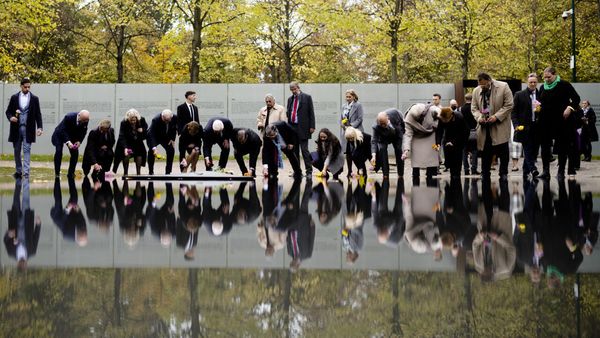
Hanae Mori was a simultaneous translator of fashion over her five decades as a designer: turning Japanese traditional fabrics into garments unscary for westerners to wear, and making western cut, fit, shape and ways of wearing comprehensible to Japanese women. She was uniquely qualified, being from the only family in her town who had dressed in western clothes at the time and the sole girl in skirt and blouse at her kimono’ed school.
Mori, who has died aged 96, never intended to be a designer; the dressmaking course she took in postwar Tokyo in her early 20s was only to equip her to make clothes for herself and her future children. But she became absorbed by western technicalities – irregular-shaped pieces, many with curved outlines, darts and gathers and drapes, all seamed together to sheath a body closely where simple Japanese tube construction wrapped it.

Photograph: Chicago History Museum/Getty
She started a small atelier above a noodle bar in Shinjuku, Tokyo, in 1951. The district had been wiped out during the second world war except for its railway station, around which, during the US occupation, grew a vast black market and entertainment economy for Americans and Japanese people. Mori, with a couple of assistants and three secondhand sewing machines, created on-spec and made-to-order fashionable western women’s clothes for both cultures.
The area had a big new cinema attracting film industry professionals; first a producer asked her to supply clothing items, then to design costumes for films – she worked on hundreds over a decade – and she also styled movie stars’ own wardrobes. At the same time, with her husband, Kenzo Mori – an executive from a textile manufacturing family – acting as manager, she expanded along with the national economy from makeshift workshop to boutiques.
Mori quickly came to represent fashion in Japan, introducing the latest trends in a newsletter that developed into a magazine, Ryuko Tsushin. She advised women on their difficult transition to western wardrobes, which made them uncomfortable by exposing more than necks and hands, mystified by alien accessories and unable to kneel on the matted floor of a chairless home.
She prospered so much that she took an unusual approach to studying French couture; in 1960, she travelled to Paris to meet and order outfits from designers she respected, including Hubert de Givenchy and Coco Chanel – who shocked Mori by advising her that she should wear orange to make an entrance. Japanese women were not expected to stand out: subtlety, reticence, what Mori called “refined hiding”, were their ideals.
On her return to Japan, her colouring brightened, and she synthesised a bolder, fusion mode, western in cut, eastern in fabric and pattern, suggesting “the atmosphere of a kimono” without its restrictions.

Mori’s first couture-level international show, East Meets West, in New York in 1965, was perfectly timed to appeal to the jet-set era’s taste for wearing floaty silk from, and in, exotic destinations; she made the glossies, was stocked by high-end department stores and began to accumulate a client list that later included Bianca Jagger, Lady Bird Johnson, Nancy Reagan, Hillary Clinton and Princess Grace of Monaco. Mori also dressed Masako Owada for her 1993 marriage to Crown Prince Naruhito.
She also learned much in the US about quality ready-to-wear, a new concept in Japan, and licensing; through these she established her name and butterfly logo in Japan and around the world.
Unlike most couturiers, she was already financially secure and intercontinentally famous when she opened her salon in Paris in 1977, and was appointed to the Chambre Syndicale de la Couture Parisienne.
Mori attributed her independence and curiosity to her father, Tokuzo Fujii, a progressive surgeon in Muikaichi (now Yoshika), Shimane, in south-west Japan; he, his daughter, and four sons all wore western dress, made from imported textiles brought back from visits to big cities, while Hanae’s mother, Nobu (nee Matsuura), wore fine kimonos ordered by catalogue from department stores; both her parents were from wealthy families.
Nobu moved to Tokyo so the children could be educated there; during the war, all of the family except Hanae were evacuated; she had been drafted into a factory, and defiantly stayed in the city during its destruction. Like other women during the war, she adopted peasant workwear – loose wrap jackets over soft tie-waist pants; Mori knew that was the moment when western dress became their future.

She married in 1947 after taking a degree in Japanese literature at Tokyo Women’s Christian University in the same year. “I was a very nice housewife for one month, but I did not like to be at home,” she said, and began the course in clothes design and construction.
Her husband supported her work, and was for decades its public front in an all-male business world of contacts and contracts. Not until 1986 was Mori invited to be the first female member of the Japan Association of Corporate Executives. By then, she was a multimillion-dollar earner, showing couture in Tokyo, New York and Paris, and fully expanded into cosmetics, perfumes, home furnishings – the whole brand-range business.
A change in the east-west balance that had established her success also determined her fate. Young designers such as Kenzo, Issey Miyake and Rei Kawakubo, whom Mori had encouraged, created a new view of Japanese design in the west, sharper and less graceful than Mori, while Japan was totally integrated into world fashion and as likely to wear Ralph Lauren denims, woven in Japan, as a Mori chiffon dress.
She sold her stores and licensed businesses to an investment group in 2002, and, with debts of ¥10bn, filed for bankruptcy for the rest of her empire, showing one last Paris collection in 2004 and retiring. But her image in Japan glows permanently, from its fashion pioneer to dowager empress. She was made a chevalier of the Légion d’honneur in 1989, and in 1996 was awarded Japan’s Order of Culture.
Kenzo died in 1996. Their two sons, Akira and Kei, who worked in Mori’s businesses, survive her.
• Hanae Mori, fashion designer and business executive, born 8 January 1926; died 11 August 2022







